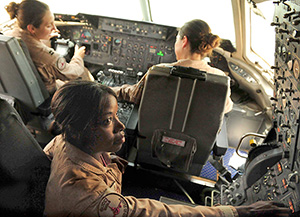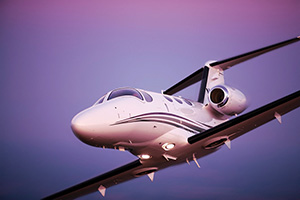Pilot Briefing
News from the world of general aviation
‘Gucci Girls’ fly Air Force tanker
 It took lots of arranging, since there is only one female Boeing KC–10 flight engineer in the U.S. Air Force, but for one mission an all-female crew operated an aerial refueling tanker above the Middle East. For this special event, the crew wore shoulder patches that said, “Gucci Girls; Unmanned KC–10 Flight.”
It took lots of arranging, since there is only one female Boeing KC–10 flight engineer in the U.S. Air Force, but for one mission an all-female crew operated an aerial refueling tanker above the Middle East. For this special event, the crew wore shoulder patches that said, “Gucci Girls; Unmanned KC–10 Flight.”
The crew took pleasure in telling fuel-hungry combat crews they were approaching an “unmanned” refueling tanker. The day-long effort was not the first of its kind. There are often all-female U.S. Air Force cargo and refueling tanker crews. There was an all-woman KC–10 crew in the mid-1980s. KC–10 pilot 1st Lt. Jen Carter said it was more about “boosting morale.” It took place from an undisclosed base in the Middle East.
The lone U.S. Air Force female KC–10 flight engineer is Staff Sgt. Sarah Lockley. “Today’s flight was awesome,” Lockley said, noting it was the first time reservists and active duty personnel have flown on the same aircraft.
“I’ve been in the Air Force for six years and it’s almost impossible to get an all-girl flight,” said Staff Sgt. Lindy Campbell, a boom operator for the 908th Expeditionary Air Refueling Squadron (EARS). “I’ve always wanted to do this. We work in a male-dominated career field, so when we figured it was possible to do it here, I jumped at the opportunity. It was nice to fly with my sisters.”
“It is a very rare occurrence,” said Lt. Col. Kenneth Moss, the 908th EARS commander. Moss thinks events like this can serve as an example of just how far women have come in the military as well.
“I think it’s great,” Moss said. “The role of women in the military has increased greatly over the years, and the presence of women in all [Air Force specialty codes] has expanded to the point that sometimes we forget how far they have had to come. However, my young daughter unintentionally reminds me every day that she needs women to look up to; she needs women to prove that nothing is impossible; she needs female role models. I think an all-female crew shows her that another potential obstacle to her dreams no longer exists.”
The aircraft commander noticed the group’s chemistry was different from normal as well.
“It went well today,” said Capt. Lindsey Bauer, 908th EARS, KC–10 left-seat commander. “Nothing against guys, but we had a relaxing time.”
SJ30 jet to continue
After months of silence from the new owner of the SJ30 jet type certificate, manufactured in the past by Sino Swearingen and Emivest, Metalcraft Technologies says the company will continue under the name SyberJet. The company uses the name MT, LLC.
SyberJet officials have moved the Martinsburg, West Virginia, assembly line to its facilities in Cedar City, Utah, and are continuing operations in San Antonio.
Mark Fairchild, the company spokesman and test pilot under past owners, is now the SyberJet general manager in San Antonio. “SyberJet has a solid operating plan to deliver new SJ30s to the world marketplace,” Fairchild said. “I look forward to providing more people the unique opportunity to experience the high-performance capability that SJ30 affords its owners and operators.”
Jet market trending upward in 2012
 Aerospace analyst Brian Foley of Brian Foley Associates says it’s time to ignore the quarterly reports, because the recovery is well in progress. Manufacturers correctly described 2010 and 2011, in advance, as “down” years, but 2012 is definitely a “recovery” year, Foley said.
Aerospace analyst Brian Foley of Brian Foley Associates says it’s time to ignore the quarterly reports, because the recovery is well in progress. Manufacturers correctly described 2010 and 2011, in advance, as “down” years, but 2012 is definitely a “recovery” year, Foley said.
“It’s never a straight line from A to B. There are setbacks,” Foley said. He had correctly predicted that piston-engine aircraft deliveries would turn upward in the first quarter of 2011, but piston sales dropped in the second quarter despite Foley’s prediction last spring that they would continue to improve. What happened? “The momentum has shifted and moved towards the recovery mode. In that process, it will be two steps forward and a step back. The trend will be up, long term,” Foley said.
“The quarterly delivery thing is a slow-motion stock market with ups and downs like you see in the stock market every day. But it is moving in the right direction once again,” Foley said.
“The new normal today is volatility,” Foley said. There will always be a steady supply of economic or political disasters from one corner of the world or another, but the market has toughened up to such news and is less affected by it,” Foley said. “What remains after the latest economic woes are stronger companies that are leaner and better able to take advantage of the expected upturn,” he said.
“People are in a much stronger position with stronger backlogs and leaner companies. They are smaller backlogs, but they are much higher caliber. The people who comprise today’s order books have the financial wherewithal to make the purchase. That wasn’t true earlier when customers needed to borrow. [Today’s customers] don’t feel compelled to cancel their order every time the stock market falls a couple of hundred points,” Foley said.
Asked if there may be a permanent distaste among boards of directors for jets, given the political criticism by members of Congress and President Barack Obama, Foley said this, too, shall pass.
“It’s a recurring event,” he said. “Any time the economy is down, as seen in previous downturns, there is an uproar over corporate jets, and it’s almost predictable. What we have learned from experience is that the rhetoric dies down with an upturn in the market.”
Cirrus completes China merger
Cirrus Aircraft announced the completion of its merger with China Aviation Industry General Aircraft (CAIGA) Co. Ltd., forming what the firm described as a worldwide general aviation enterprise.
Brent Wouters, Cirrus president and CEO, said the merger would benefit Cirrus customers and its business because the firm will have "the resources that will allow us to expedite our aircraft development programs and accelerate our global expansion."
AOPA reported February 28 that the merger, under negotiation for 20 months, would leave Cirrus in operation in Duluth, Minnesota, and Grand Forks, North Dakota. Wouters said the deal would preserve the dream of the company founded by Alan and Dale Klapmeier to design cutting-edge aircraft. Alan left Cirrus in 2009 and now heads Kestrel Aircraft, which is developing a single-engine turboprop in Brunswick, Maine. Dale remains at Cirrus as chairman.
Wouters cited the merger as a catalyst for expansion at Cirrus following two years in which the company drastically cut back its workforce and backed off the development of its Vision single-engine, V-tail jet.
CAIGA understands "the strength and the talent of Cirrus's workforce who have made the Cirrus brand so successful and prominent in the general aviation marketplace. CAIGA will continue to invest in our employees and in our world-class production facilities in Minnesota and North Dakota," he said.
Completion of the merger was contingent on approval of the federal Committee on Foreign Investment in the United States, an interagency panel that reviews transactions leading to control of a domestic company by foreign interests.
Other principals in the transaction also commented on the merger in the announcement on the Cirrus website.
"We are very impressed with Cirrus' performance in the global general aviation industry," said Meng Xiangkai, CAIGA's president. "It has a very strong record of consistent product excellence, comprehensive safety features, an outstanding management team, and a highly skilled workforce who operate from advanced production facilities."
Dale called the merger an important milestone in the company's history and "…a very positive development that allows us to continue our mission to develop and build the best, most exciting aircraft in the world."
Cirrus has delivered nearly 5,000 new piston airplanes over the last decade, with the SR22 family of aircraft
becoming "the best-selling four-place airplane in the world," said the announcement. —Dan Namowitz
Test Pilot By Barry Schiff
-
 Teledyne Continental Motors does not consider oil consumption to be cause for concern unless it exceeds 1 quart every _____ hour(s). It is not considered an airworthiness issue unless it exceeds about 1 quart every _____ hour(s).
Teledyne Continental Motors does not consider oil consumption to be cause for concern unless it exceeds 1 quart every _____ hour(s). It is not considered an airworthiness issue unless it exceeds about 1 quart every _____ hour(s). - True or False: A pilot is crabbing left to stay on course while flying in cloud. He is maintaining a constant indicated altitude but is unable to get a current altimeter setting as he proceeds. This means that the pilot is slowly and unwittingly losing altitude.
- What famous pilot's mother's curiously melodious name is better known than his own?
- True or False: With respect to horizontally opposed Continental and Lycoming engines, the number-one cylinder is the rearmost cylinder on the right.
- From reader John Schmidt: What did the producers of the classic movie Tora Tora Tora! do to convince the owner of a Boeing B–17 Flying Fortress to make the actual one-wheel landing shown in the movie?
- Which of the following does not belong?
a. heavy rain from a thunderstorm
b. virga
c. trees bending with the wind
d . a ring of blowing dust - What famous pilot was a spokesperson for a company that made a watch that ran backwards?
- Why were some Japanese World War II fighters called Zeros?
Kitfox installs Lycoming 'light sport' engine
Kitfox Aircraft officials say they are one of the first manufacturers to fly one of its aircraft powered by Lycoming's new O-233 engine, a 115-horsepower powerplant with a Champion electronic ignition system designed for the light sport market.
The Lycoming powered a Kitfox S7 Super Sport during test and performance-gathering flights. After about 20 hours of local flying, the aircraft flew from the Kitfox base in Homedale, Idaho, to EAA AirVenture 2011 in Oshkosh, where the aircraft was displayed in front of Lycoming's tent, said a Kitfox spokesman.
"We did not want to release information until we were sure we were ready," said John McBean of Kitfox, who added that the aircraft's being on display "front row, center stage" attracted a lot of attention from LSA pilots.
Lycoming, of Williamsport, Pennsylvania, announced in July 2010 that it had begun taking orders for the O-233 engine. Lycoming described the engine, with a 2,400-hour time between overhaul and the capability to run on auto fuel or avgas, as an important new engine to meet the needs of "a whole new segment of the flying public." —DN
Upgraded Hawker 800 wins FAA approval
The FAA has awarded a supplemental type certificate to equip the Hawker 800XPR with Honeywell TFE731-50R engines and factory winglets. The work will be done by factory-owned Hawker Beechcraft Services facilities.
Customer deliveries were to start in September.
"The Hawker 800XPR factory upgrade underscores our commitment to our customers with products that improve performance, lower operating costs and increase resale value of the aircraft we design and build," said Christi Tannahill, Hawker Beechcraft vice president. "As the first of two Hawker XPR upgrade programs in development, the 800XPR will be joined by the 400XPR that is expected to certify in 2012."
Capable of producing 5,000 pounds of thrust but flat rated to 4,660 pounds, the Hawker 800XPR's new engines improved performance and, thanks to lower temperatures, increase durability. The engines reduce fuel consumption by 7 percent. The new engines also deliver a number of green advantages, such as lower noise levels and reduced carbon emissions.
TEST PILOT ANSWERS
- 3, 1
- True. The left crab indicates that the aircraft is proceeding toward a low-pressure area. Lacking a current altimeter setting, true altitude at such a time becomes less than indicated altitude. This is a variation of Buys Ballot's Law: "If your back is to the wind, lower pressure is to your left (in the Northern Hemisphere)."
- The Boeing B–29 Superfortress used to drop the atomic bomb on Hiroshima was the Enola Gay, mother of the bomber's command pilot, Paul W. Tibbets.
- It is true on Continental engines, but the number-one cylinder on a Lycoming is the most forward cylinder on the right (with respect to tractor engines, not pusher engines).
- Nothing. The producers took advantage of a landing-gear malfunction by asking the pilot to delay his landing until a film crew could be put into position.
- (c) The other items are visual signs indicating the possible presence of a microburst.
- After returning from his flight from New York to Ireland, Douglas "Wrong Way" Corrigan endorsed a number of products that operated the wrong way.
- They were technically called Zero Zeros, which represented the last two digits of the year in which they were designed, the 2,600th year of the Nipponese Dynasty (1942).
Students claim human-powered chopper record
The National Aeronautic Association has certified the July 13 record for the University of Maryland's human-powered helicopter, called Gamera. It lifted off and hovered for 11.4 seconds, setting U.S. records for flight duration, and for flight duration by a female pilot.
It was designed and built by graduate and undergraduate students at the University of Maryland's A. James Clark School of Engineering, and piloted by biology student Judy Wexler, a bicycle enthusiast.
The NAA has submitted its findings to the Fédération Aéronautique Internationale (FAI) for evaluation as world records in the same categories. The process may take two to three months. A May flight for liftoff is also under evaluation by FAI.
Now, the question is what to do next. Do you set another, better record, or do you just go for it all, represented in this case by the Sikorsky Prize? The American Helicopter Society's Sikorsky Prize requires a human-power helicopter to hover for a full minute, and to go as high as three meters, all while remaining in a 10-square-meter area.
Sonex kit maker flies single-engine jet
 Sonex Aircraft, the Wisconsin-based kit aircraft manufacturer, has flown a single-engine jet model called the SubSonex. It was flown by Bob Carlton, who uses a jet-powered glider in his airshow act. The flight originated at Wittman Regional Airport in Oshkosh and lasted 14 minutes.
Sonex Aircraft, the Wisconsin-based kit aircraft manufacturer, has flown a single-engine jet model called the SubSonex. It was flown by Bob Carlton, who uses a jet-powered glider in his airshow act. The flight originated at Wittman Regional Airport in Oshkosh and lasted 14 minutes.
The flight concentrated on low-speed maneuvers, including stalls. "It's an exciting day for Sonex," said SubSonex designer and Sonex Aircraft President John Monnett. "We have a test flight plan to expand the envelope of the aircraft, and we'll see where the project takes us from here."
"It was great—flies like an airplane," Carlton said after the flight. "The faster I went, the better it felt." Bob Carlton is best known for his airshow performances with the Super Salto jet sailplane, and is the developer of the Bonus Jet two-seat glider. The engines used on Carlton's aircraft are the same as that used on the SubSonex: the PBS TJ-100.
Aircraft sales down in first six months
Worldwide sales of general aviation aircraft fell 15.5 percent during the first six months of 2011, said the General Aviation Manufacturers Association (GAMA) and an aerospace workers union in a statement that blamed political rhetoric for demonizing the industry and taking away jobs.
GAMA sales figures also showed total billings for GA airplanes of $7.3 billion, down 22.3 percent, in a "difficult year" for aviation manufacturers.
According to GAMA, piston-powered airplane shipments totaled 387 units compared to 424 units delivered in the first six months of 2010, a decrease of 8.7 percent. Turboprop shipments declined 8.9 percent or 143 units in 2011, compared to 157 units in the 2010 period. Some 261 business jets were shipped—down 26.5 percent.
While billings and shipments declined overall for the industry, Piper Aircraft found a bright spot. Piper reported that its billings grew nearly
16 percent during the first six months of the year to $57.3 million. The company sold a total of 38 Meridians, Matrixes, and Mirages, up two aircraft over the same six-month period during 2010. —DN


